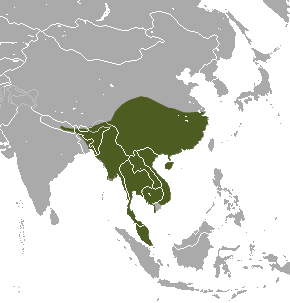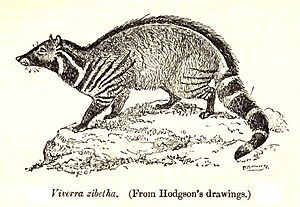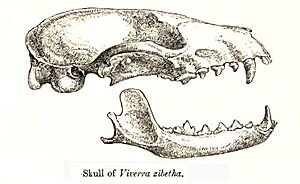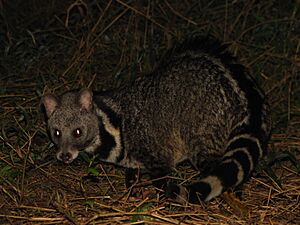Large Indian civet facts for kids
Quick facts for kids Large Indian civet |
|
|---|---|
 |
|
| Conservation status | |
| Scientific classification | |
| Genus: |
Viverra
|
| Species: |
zibetha
|
 |
|
| Large Indian civet range | |
The large Indian civet (Viverra zibetha) is a cool animal from the civet family. It lives in parts of South and Southeast Asia. Sadly, its numbers are slowly going down. This is mainly because people hunt them and set traps. They are hunted for their meat and other products. Because of this, it's listed as "Least Concern" on the IUCN Red List, but we still need to watch out for them.
Contents
What Does It Look Like?
The large Indian civet has fur that is grey or brownish-yellow. It has a black stripe running down its back, from its shoulders to its tail. Its face has a whitish patch on the front of its nose, with blackish areas behind it. The chin and front of its throat are also blackish.
Around its neck, it has cool black stripes with white spaces in between. Its tail has a different number of black and white rings. These rings go all the way around its tail. This animal can pull its claws back, just like a cat! The bottom of its feet are covered in hair.
This civet is quite big, as its name suggests. It's probably the largest type of Viverra civet. Only the African civet and binturong are bigger in the civet family. Its body and head can be from 50 to 95 centimeters (about 20 to 37 inches) long. Its tail adds another 38 to 59 centimeters (about 15 to 23 inches). Its back feet are about 9 to 14.5 centimeters (about 3.5 to 5.7 inches) long. These civets usually weigh between 3.4 and 9.2 kilograms (about 7.5 to 20 pounds). Some people say they can even weigh up to 11 kilograms (about 24 pounds)!
Where Do They Live?
The large Indian civet lives in many countries across Asia. You can find them in Nepal, northeast India, Bhutan, and Bangladesh. They also live in Myanmar, Thailand, the Malay Peninsula, and Singapore. Further east, they are found in Cambodia, Laos, Vietnam, and China.
In Nepal, these civets have been seen high up in the Himalayas. They can live at elevations of up to 2,250 meters (about 7,380 feet).
In China, the number of wild large Indian civets has dropped a lot. Their population has gone down by 94–99% since the 1950s. This big drop is due to forests being cut down, which destroys their homes. They were also hunted for their fur and other animal products. By the 1990s, most of them were only found in the north of Guangdong Province in southern China. Sadly, they haven't been seen on Hainan Island in surveys done between 1998 and 2008.
Daily Life of a Civet
The large Indian civet is a loner. It likes to be by itself. It is also nocturnal, which means it is most active at night. During the day, it usually rests. These civets spend most of their time on the ground.
They are "opportunistic hunters." This means they will eat whatever small animals they can find. They hunt a wide variety of small creatures for food.
Studies in Thailand using radio tracking showed that large Indian civets have a home range of about 2.7 to 8.8 square kilometers (about 1 to 3.4 square miles). This is the area they usually travel within to find food and shelter.
Protecting the Civet
The large Indian civet (Viverra zibetha) is a protected species in Hong Kong. This means it's against the law to harm them there. However, this civet hasn't been seen living naturally in Hong Kong since the 1970s. Because of this, it's thought to be locally extinct there. This means it no longer lives in the wild in that specific area.
About Their Name

The scientific name for the large Indian civet is Viverra zibetha. This name was first given by a famous scientist named Carl Linnaeus in 1758. Scientists use these special names so everyone around the world knows exactly which animal they are talking about.
Images for kids





